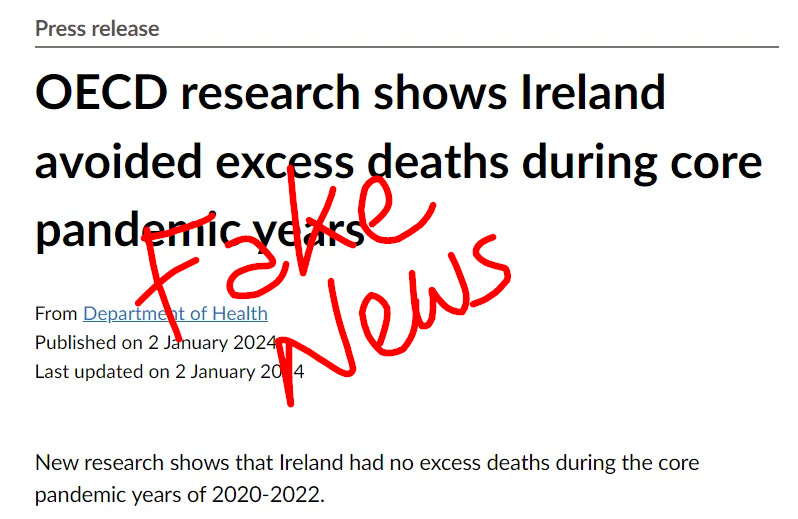A small update on the state of affairs regarding the Irish Department of Health’s fake news reporting earlier this year on excess mortality rates during the pandemic.

Double Standards
The Dept. of Health has engaged in blatantly inconsistent presentations of age-standardised death rates for the pandemic years. When presenting figures calculated in-house and featured in its publication Health in Ireland: Key Trends it has adhered to rigorous guidelines on the dissemination and quality of official statistics, and made sure to provide detailed notes on the data. We initially missed the latest publication for key trends in 2023 when released 28 February 2024:

Source: Central Statistics Office, Public Health Information System (PHIS) - Department of Health.
Notes: (i) (p) The figures for 2022 are provisional. They should be treated with caution as they refer to deaths registered in this year and may be incomplete. Figures for previous years may be different from those in earlier publications due to late-registered deaths or revised population estimates.
Best Practice - Proceed with Caution
The figures for 2022 are clearly indicated as “provisional”. The reader is advised to treat such figures “with caution”. Readers are kindly informed of a distinction wherein the provisional figures refer to “deaths registered” in that year (not deaths occurring in that year). The bottom line is that such data “may be incomplete”. The notes even mention an additional tricky phenomenon (oft discussed here), namely “late registered deaths” which result in figures from previous publications being revised upwards. And they obliquely inform us population estimates have been revised (in September 2023). That, ladies and gentlemen, is how the Department of Health can annotate statistics when it wants to.
Similarly, in a parliamentary debate (Trends in Mortality and Estimates of Excess Mortality) on 18 October 2023 - one month before the OECD paper was published - the Minister of State for Public Health, Hildegarde Naughton, made sure to explicitly state the provisional nature of the age-standardised all-cause death rate she cited for 2022 and to also highlight “final” deaths data was then available only up to the year 2020. While the Minister of State undeniably obfuscated and cherry picked in an attempt to fob off concerns of excess deaths in recent trends of Irish mortality rates, she explicitly qualified the limitations of the data she cited.
Official data on mortality in Ireland is collected by the CSO based on deaths registered with the General Register Office, GRO. The latest final data on deaths from the CSO is for the deaths occurring in 2020…
Ireland’s age-standardised all cause death rate declined steadily from 1,152 deaths per 100,000 in 2007 to 923 per 100,000 in 2019. In 2022, the provisional age-standardised all cause death rate was 937 per 100,000. While this was an increase from 2021, it was below the age-standardised all cause death rate of years prior to 2018…
Oops! - Throwing Caution to the Wind
In stark contrast, when the Dept. of Health on 2 January 2024 claimed the findings of the OECD Health Working Paper showed Ireland “avoided excess deaths during the core pandemic years”, it failed to mention any limitations of the Irish data used, although the OECD paper explicitly states in its footnotes “Ireland: Data for 2021 to 2022 are provisional and subject to change.” Note, of approx. 40 countries analysed, only Ireland and the UK had such a footnote appended.

No indication of the provisional basis of the data source used. Zero mention of proxy “deaths registered” figures instead of “deaths occurring” for pandemic years 2021 and 2022. No hint of incompleteness. Not a whisper of “late registered deaths”. And, most importantly of all, no recommendation to treat the provisional figures with CAUTION!
Incompetence or Malevolence?
Sorry, but the Dept. of Health clearly knows how to present statistics professionally, so one can only reason that the presentation of the OECD’s estimates dispensing with standard basic practice for the dissemination and quality control of official statistics was either professional incompetence - OR - deliberate misinformation.
Feigning Ignorance
Recall, though the Irish Minister of Health Stephen Donnelly has repeatedly stated his department does not produce estimates of excess mortality, he is certainly aware his department produces age-standardised all-cause death rates, which are an ideal basis for estimating excess mortality. There are different approaches to calculating estimates of expected deaths, but even he knows knows how to calculate a five-year average. Alas and alack, his department still cannot produce any in-house estimates of excess mortality.
Official Data
Curiously, the Key Trends 2023 publication again neglects to graphically illustrate the long-term trend of all-cause ASMR, so we have plotted the latest figures for the Minister using his department’s own calculations for 2007-2022, which offer a clear picture of the trends in mortality.
Please observe the notes. Left axis - total deaths, right axis - ASMR. These Dept. of Health figures do not include “late registered deaths”. Figures for 2022 are provisional, based on “deaths registered” and not “deaths occurring”. Approximate expected upward revisions of 2022 provisional figures are illustrated with feint arrows.
ASMR: What went down, now goes up
Pre-pandemic (inclusive 2020): steadily rising deaths totals, slightly rising crude death rate, steadily falling age-standardised death rate.
Pandemic (2021-2022): significant upward deviation from trend, significant increases in deaths totals, and crude death rate, significant increase in age-standardised death rate.
Recall, age-standardised mortality rates take account of differences in population structure. The inversion of trend in ASMR is a glaringly obvious case of more-than-expected deaths and implicitly signals excess mortality. A monthly or seasonal analysis reveals the significant cumulative excess deaths started in the latter half of 2021 and had not recovered by end of 2022. While the figure for 2020 represents a year-on-year increase, it is not significantly off trend.
Lies of Omission and Narrative Fallacy
What is lying by omission? Lying by omission is the deliberate act of leaving out important details so the truth is skewed or misrepresented.
The narrative fallacy is the tendency to create a story with cause-and-effect explanations out of random details and events



After presumably being advised by professional statisticians in the Department of Health, the Minister for Health, Stephen Donnelly, the Chief Medical Officer, Prof. Breda Smyth, and the head of government, Leo Varadkar, thus all lied when claiming the OECD paper showed Ireland avoided excess deaths during the pandemic. These public health representatives furthermore engaged in narrative fallacies by weaving a story out of self-congratulatory talking points to justify the counter-intuitive findings of the OECD paper: Ireland’s adherence to stringent public health measures was so successful; Ireland’s Covid-19 vaccination campaign (96% of adults jabbed!) was one of the most successful in the world; of course vaccines save lives; remember to get boosted (again). Isn’t Ireland a great little country!
CMO - Another pandemicist exits stage left
The shameless lies may well have been told with an understanding of “I’ll be gone, you’ll be gone”, for example, the Chief Medical Officer has since announced she is moving on. She is leaving her governmental post to return to the safer an better remunerated world of academia at the Royal College of Surgeons Ireland (RCSI). Let’s hope she refrains from any departing pinnochios regarding Ireland’s pandemic excess mortality on the way out 🙏
===
P.S. - Devil in the Detail
To preempt anyone commenting that the numbers are actually even worse than depicted above - yes. We are still waiting on more “late registered deaths” for 2020-21 and, of course 2022. In this post, we have simply stuck to the Department of Health’s own latest official figures available (as of 31 October 2023) in order to demonstrate its duplicity in the face of its own data - in other words there is no room for plausible deniability.
Meanwhile Eurostat continues to overestimate Irish excess mortality and scarify with it’s simplistic fixed baseline, whereas EuroMOMO continues to underestimate Irish excess mortality with it’s over-compensatory method undermining long-term trends. Note, for 2023, the official provisional figures for deaths registered show signs of the excess mortality abating.
===
Covid-19 Inquiry in Limbo
Irish government plans announced at the start of the year to conduct a Covid-19 Inquiry have seemingly stalled with no date in sight. Reportedly there will be a public element - Witzbold will have a comprehensive analysis of trends in Irish mortality at the ready.






